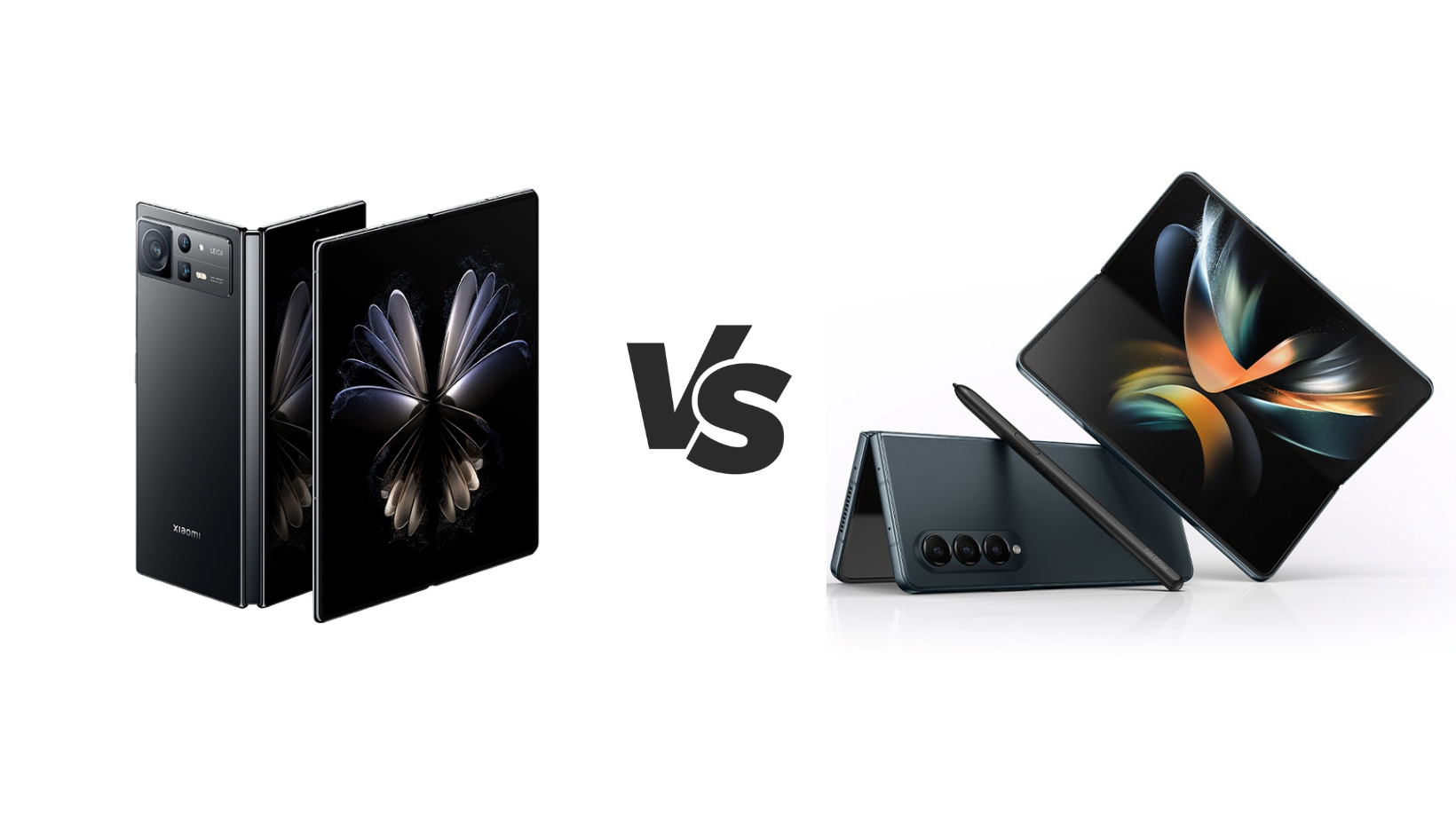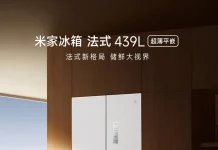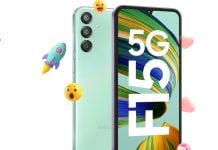Over the past couple of years, foldable smartphones have matured to an extent where it can be your daily driver. The earlier generations were far from perfect, plagued with issues such as a visible crease on the internal screen, less durable components, and even a lack of IP certification.
But things have changed now. The newly launched Galaxy Z Fold4 and the Xiaomi Mix Fold 2 are two of the best foldable smartphones that you can buy on the market. Given that the two companies announced their models almost around the same time, it makes complete sense to compare the two models.
Let’s take a quick look at the Xiaomi Mix Fold 2 vs Samsung Galaxy Z Fold4 comparison and see how they fare against each other.
Xiaomi Mix Fold 2 vs Samsung Galaxy Z Fold4
| Xiaomi Mix Fold 2 | Galaxy Z Fold4 | |
|---|---|---|
| DIMENSIONS AND WEIGHT | Unfolded: 161.1 x 144.7 x 5.4mm Folded: 161.1 x 73.9 x 11.2mm 262 g |
Unfolded: 155.1 x 130.1 x 6.3mm Folded: 155.1 x 67.1 x 14.2-15.8mm | 263 g |
| DISPLAY | Foldable: 8.02-inch 2160 x 1914p 120Hz, HDR10+, Dolby Vision Cover: 6.56 2520 x 1080p 120Hz, HDR10+, Dolby Vision |
Foldable: 7.6-inch 2170 x 1812p 120Hz, HDR10+, Dolby Vision Cover: 6.2 2316 x 904p 120Hz |
| PROCESSOR | Qualcomm Snapdragon 8+ Gen1 clocked at 3.2GHz | Qualcomm Snapdragon 8+ Gen1 clocked at 3.2GHz |
| MEMORY | 12 GB RAM, 256 GB – 12 GB RAM, 512 GB – 12 GB RAM, 1 TB | 12 GB RAM, 256 GB – 12 GB RAM, 512 GB – 12 GB RAM, 1 TB |
| SOFTWARE | Android 12, MIUI Fold 13 | Android 12L, One UI 4.1.1 |
| CONNECTIVITY | Wi-Fi 802.11 a/b/g/n/ac/6, Bluetooth 5.3, GPS | Wi-Fi 802.11 a/b/g/n/ac, Bluetooth 5.2, GPS |
| CAMERA | Triple 50 + 8 + 13 MP, f/1.8 + f/2.6 + f/2.4 20 MP f/2.4 front camera |
Triple 50 + 10 + 12 MP, f/1.8 + f/2.4 + f/2.2 4 MP + 10 MP front cameras |
| BATTERY | 4500 mAh, fast charging 67W | 4400 mAh, 25W | 15W Wireless Charging |
| ADDITIONAL FEATURES | 5G, dual SIM | 5G, dual SIM |
Design
The Xiaomi Mix Fold 2 and the Samsung Galaxy Z Fold4 feature an inward folding design. This means that both phones feature two displays. One is a large tablet-like display that folds inwards and there’s another external display for use in the folded state.
Given their similar design philosophies, we can directly compare the two foldable in the design department.
The Galaxy Z Fold4 comes with a more curved and rounded design, similar to its predecessor. On the other hand, the Xiaomi Mix Fold 2 adopts a boxier design profile, similar to the Galaxy Note series designs we’ve seen earlier. That said, both the phones look premium and polished for their prices with the Xiaomi foldable coming in standard black and gold colors, while the Samsung models adding in fancier Burgundy and Graygreen color options.
Another big difference is in the styling of the camera modules. The Galaxy foldable features a vertical camera module, housing its three cameras while the Xiaomi foldable comes with a rectangular camera module, featuring its three cameras. This gives the Xiaomi Mix Fold 4 a more symmetric look than the Galaxy model.
As for its dimensions, the Xiaomi model does have an advantage here, being just 5.4mm thick in the tablet mode (vs 6.3mm on the Galaxy Fold 4). Even in the folded state, it is way thinner than the Galaxy model at 11.2mm (vs 14mm).
Notably, the Xiaomi model is larger than the Samsung one, thanks to its larger displays on both the front and the back. However, unlike the Samsung model, it does not come with stylus support, which is a shame.
There’s no clear winner in this department as both are well-built foldables on paper.
Display
Let’s start with their unfolded displays first. Thanks to its larger dimensions, the Xiaomi Mix Fold 2 brings a larger display compared to the Galaxy Z Fold 4. It features an 8.02-inch 1914 x 2160 foldable OLED panel with 120Hz refresh, HDR10+, Dolby Vision on the inside, and a 6.56-inch 1080 x 2520 resolution screen with a 21:9 ratio, 120Hz refresh rate, and HDR10+ support on the outside.
In comparison, the Galaxy Z Fold4 features a 7.6-inch 1812 x 2176 HDR10+, 120Hz panel on the inside, and a 6.2-inch 904 x 2316 screen with a 23.1:9 aspect ratio, 120Hz refresh rate on the outside.
As you can see, both the displays boast top-end specs on paper, and it’s good to see both phones adding 120Hz refresh rate support on their internal and external screens. However, Xiaomi seems to have an advantage in terms of sizing and aspect ratio. If you look closely, the external display of the Xiaomi model features a standard aspect ratio of 21:9 which is not the case with Samsung’s 23.1:9 screen.
Both the models feature Ultra Thin Glass (UTG) protection on their foldable internal screen.
Finally, we can’t talk about foldable screens without really talking about creases. This is where the Samsung model could have the advantage with the company coming close to perfecting the art of limiting the visible crease on its display. Xiaomi also boasts of crease-less displays but Samsung seems to have the advantage here.
Specs & Software
The two foldables are evenly matched when it comes to the hardware. Both the models come with the 3.2GHz Snapdragon 8+ Gen1 chip, which is the best smartphone chipset for Android phones in 2022. With options of up to 1TB of storage and 12GB of RAM on both models, they will never be short of power, be it for heavy gaming or running intensive apps. Even multitasking should be a breeze.
That said, the software is where the two phones should differ significantly. The Xiaomi model comes with Android 12-based MIUI Fold 13 OS. This is similar to the OS that runs on its smartphones with a few adaptations (like multitasking) for its foldable form factor.
On the other hand, the Galaxy Z Fold4 comes with a dedicated OS for large screens, giving it an edge. It features the Android 12L OS with OneUI 4.1.1 on top of it, adding tablet-specific features like Samsung Flex, making the experience a lot more productive and fun.
While in terms of processing power, both the phones are well matched, the software is one area where Samsung brings its rich experience in the field of foldables. This gives the Galaxy Z Fold 4 an edge in this department.
Camera
The camera is another department where the two phones are well matched.
The Samsung Galaxy Z Fold4 comes with a 50MP f/1.8 primary camera with OIS, another 10MP 3x telephoto zoom camera with OIS, and a 12MO ultra wide-angle shooter with 123˚ FoV. On the inside, the phone features a 4MP f/1.8 selfie shooter which is under the display. The Samsung model also adds another 10MP selfie camera on its cover display.
In comparison, the Xiaomi Mix Fold2 comes with a 50MP f/1.8 primary camera with OIS, 8MP 2x optical zoom telephoto lens and a 13MP 123˚ ultra-wide shooter. It features a 20MP selfie camera on the front.
As you can see, both the models feature a solid camera setup, comparable to the flagships of 2022. They even support up to 8K video recording.
Battery
It’s the year 2022 but foldable smartphones still lack large batteries. The Xiaomi Mix Fold 2 comes with an average 4500mAh capacity battery and 67W charging. On the other hand, the Galaxy Z Fold4 comes with a 4400mAh battery with 25W charging support.
However, the Galaxy foldable, like its predecessor, comes with wireless and reverse wireless charging support at 15W, which is absent on the Xiaomi model.
Price
The Galaxy Z Fold4 starts at $1,799.99/£1,649/€1,799 globally. On the other hand, the Xiaomi Mi Mix Fold 2 retails for around 8,999 yuan (~$1,335) in China. But you can get it globally via sites like Giztop for $1799.
Samsung’s Galaxy Z Fold4 brings multiple generations of refinements, making it one of the best foldables of 2022. However, the phone is still pretty pricey, especially when you compare it to the Xiaomi Mix Fold 2. In terms of hardware, they are pretty evenly matched, however, the Samsung model would have an advantage in the software department.
If Xiaomi makes the foldable available globally for a cheaper price than the Galaxy Z Fold4, it will make the foldable market a lot more interesting in the coming weeks.
Galaxy Z Fold4 vs Xiaomi Mix Fold2: PROs and CONS
Galaxy Z Fold4
PRO
Relatively Compact Form Factor
Wireless Charging Support
IPX8 water resistance
Stylus Support
Better Software Experience
CONS
Expensive
Slower Wired Charging
Unconventional Display Aspect Ratios
Xiaomi Mix Fold2
PRO
Slim Form Factor
Large Displays
Fast 67W Fast Wired Charging
Cheaper Pricing
CONS
No Stylus Support
No Wireless Charging
No IP rating
Limited Availability
RELATED
- Xiaomi Mix Fold 2 Unboxing: The Thinnest Foldable Phone
- Best Smartphones for Seniors 2022
- Best Cases for Xiaomi 12S Ultra — Carbon Fiber, Leather, Armored, Ring , Kickstand and more
- Best Tablets under Rs 30000 in India (August 2022)
- Best Wireless Mouse 2022
Check the latest videos from our YouTube channel and subscribe:







